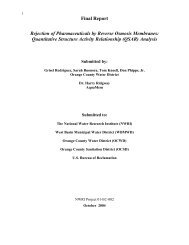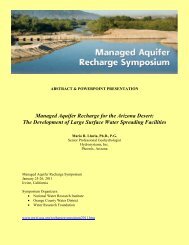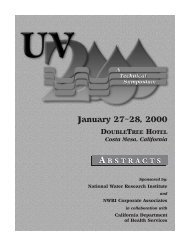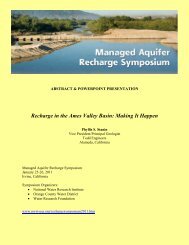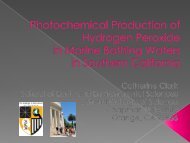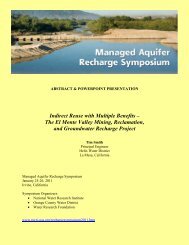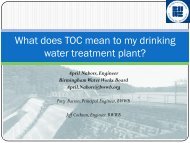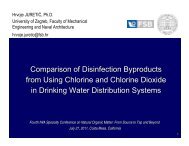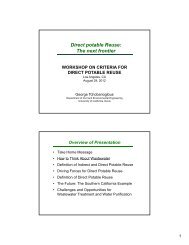RBF_Cover (for eps) - National Water Research Institute
RBF_Cover (for eps) - National Water Research Institute
RBF_Cover (for eps) - National Water Research Institute
You also want an ePaper? Increase the reach of your titles
YUMPU automatically turns print PDFs into web optimized ePapers that Google loves.
Session 2: Operations<br />
Bridging <strong>Research</strong> and Practical Design Applications<br />
David L. Haas, P.E.<br />
Jordan, Jones & Goulding, Inc.<br />
Norcross, Georgia<br />
Michael J. Robison, P.E.<br />
Jordan, Jones & Goulding, Inc.<br />
Norcross, Georgia<br />
David R. Wilkes, P.E.<br />
Jordan, Jones & Goulding, Inc.<br />
Norcross, Georgia<br />
Background<br />
The Louisville <strong>Water</strong> Company operates two water filtration plants: the B.E. Payne <strong>Water</strong> Treatment<br />
Plant (Payne Plant), which has a treatment capacity of 60 MGD (227,000 cubic meters per day [m 3 /d])<br />
and is located in eastern Jefferson County, Kentucky; and the Crescent Hill <strong>Water</strong> Treatment<br />
Plant, which is located closer to downtown Louisville and has a treatment capacity of 180 MGD<br />
(682,000 m 3 /d). Both are conventional surface-water treatment plants drawing their supply from<br />
the Ohio River. The Payne Plant has two 60-inch (1.5-meter [m]) raw-water intake pipes located<br />
on plant property. The intake <strong>for</strong> the Crescent Hill <strong>Water</strong> Treatment Plant is located near the<br />
intersection of Zorn Avenue and River Road, approximately 7 miles (4.4 kilometers) downstream<br />
from the Payne Plant intake.<br />
In 1999, the Louisville <strong>Water</strong> Company started operating a horizontal collector well at its<br />
Payne Plant. This horizontal collector well consists of a 16-ft (4.9-m) diameter caisson.<br />
The caisson was constructed down to the top of bedrock and is approximately 100-ft (30.5-m)<br />
deep. There are seven 12-inch (30.5-centimeter) collector laterals radiating out horizontally from<br />
the caisson. A pump station was constructed on top of the caisson above the flood plain to pump<br />
water to the Payne Plant <strong>for</strong> further treatment. The design capacity of this well is 15 MGD<br />
(57,000 m 3 /d).<br />
Jordan, Jones & Goulding, Inc. was retained by the the Louisville <strong>Water</strong> Company to implement<br />
<strong>RBF</strong> <strong>for</strong> the remainder of the Payne Plant. This second phase of <strong>RBF</strong> will provide an additional<br />
45 MGD (171,000 m 3 /d) of capacity. Ultimately, the Louisville <strong>Water</strong> Company desires to extend<br />
<strong>RBF</strong> technology to the Crescent Hill <strong>Water</strong> Treatment Plant.<br />
This paper provides a summary of issues that were faced in taking the concept of providing<br />
additional <strong>RBF</strong> capacity <strong>for</strong> the Payne Plant through design. There were three primary areas that<br />
Correspondence should be addressed to:<br />
David L. Haas, P.E.<br />
Senior Project Manager<br />
Jordan, Jones & Goulding, Inc.<br />
6801 Governors Lake Parkway • Norcross, Georgia 30071 USA<br />
Phone: (678) 333-0242 • Fax: (678) 333-0828 • Email: DHAAS@JJG.com<br />
7



